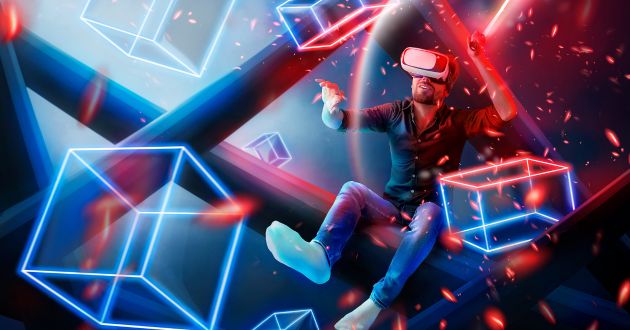Anúncios
Virtual reality (VR) gaming has continuously evolved, pushing the boundaries of immersive entertainment. With advancements in technology, new games, and innovative VR systems, the latest virtual reality gaming experiences are more interactive and realistic than ever before.
This article explores recent developments in VR gaming, highlighting the new features that enhance player interaction and realism.
Introduction to Modern VR Gaming
Virtual reality (VR) gaming has evolved from a concept of futuristic play to a tangible, highly immersive form of entertainment enjoyed by millions around the world. The latest virtual reality gaming experiences harness cutting-edge technology to deliver incredibly realistic environments, intuitive gameplay mechanics, and interactive narratives that respond to the player’s decisions and movements. This new era of gaming is defined by its ability to transport players completely into another world, whether it be a fantastical landscape, a distant planet, or a historical recreation.
The core appeal of modern VR gaming lies in its immersive quality. With advanced VR headsets and sensory feedback systems, players can see, hear, and even feel the game environment in ways that traditional gaming could never offer. This level of immersion enhances emotional engagement and heightens the sense of presence, making each session more intense and memorable.
Anúncios
Latest virtual reality gaming experiences…

Furthermore, the latest virtual reality gaming experiences are not just about the individual gameplay but also about fostering social connections in a virtual space. Multiplayer VR games allow players to interact in real-time with friends or strangers, creating communities within the digital realm. This social aspect is proving to be as significant as the games themselves, promoting a new type of digital socialization.
Innovation is continuously driving the VR gaming industry forward. Developers are exploring new possibilities with VR by integrating artificial intelligence to create more dynamic and adaptable game worlds. These environments can react in real-time to players’ actions, providing a unique experience for every session. This level of personalization and reactivity adds a profound depth to gaming, setting the stage for future developments that could redefine interactive entertainment.
As we delve deeper into the latest virtual reality gaming experiences, we see a blend of technology, art, and social science coming together to craft experiences that are not only entertaining but also enriching and transformative. This is the new frontier of gaming — a world where the digital and physical merge to create experiences beyond the imagination.
Top VR Games Released This Year
The current year has seen the release of several VR games that have set new standards in terms of gameplay depth and immersive experience.
Below is a table summarizing the top three VR games released this year, along with their unique features:
| Game Title | Developer | Unique Features |
|---|---|---|
| Astra’s Odyssey | Starlight Studios | Extensive open-world exploration, multiplayer |
| Echoes of the Void | Void Creations | Narrative-driven, emotional storytelling |
| Rift Runners | Quantum Leap | Advanced physics interactions, co-op mode |
Each of these games introduces fresh gameplay mechanics and storytelling techniques that enhance the latest virtual reality gaming experiences.
Technological Advancements in VR Systems
Recent technological advancements have significantly improved how VR games are played. These include higher resolution displays, faster refresh rates, and reduced latency, all of which contribute to more realistic and comfortable gaming sessions. Moreover, new VR accessories like haptic feedback suits and advanced motion controllers have made VR gaming more intuitive and physically engaging.
The Impact of VR on Social Interaction
Interestingly, VR gaming has also begun to change how people interact socially. Through multiplayer experiences and virtual social spaces, players can meet, collaborate, and compete in ways that mirror real-life interactions. This social dimension is particularly compelling during times when physical interaction is limited.
Future Trends in VR Gaming
Looking forward, the latest virtual reality gaming experiences are set to become even more sophisticated with the integration of artificial intelligence and machine learning.
These technologies promise to create more dynamic and responsive gaming environments that can adapt to individual player actions and preferences, potentially changing the way games are designed and played.
FAQ: Latest Virtual Reality Gaming Experiences
1. What are virtual reality (VR) games?
VR games are interactive experiences using VR technology that simulates a player’s physical presence in a digital environment. Players use VR headsets to experience sights and sounds that mimic real-world or fantastical settings.
2. What do I need to start playing VR games?
To start playing VR games, you need a VR headset, a compatible gaming platform (like a PC, console, or standalone VR device), and VR controllers. Some games may also require additional accessories for enhanced interaction.
3. Are VR games expensive?
The cost of VR games varies. While some indie and simpler games may be relatively inexpensive, high-end games with detailed graphics and extensive gameplay can be more costly. Additionally, the hardware required for VR gaming can be a significant investment.
4. Can VR games cause motion sickness?
Yes, some people may experience motion sickness while playing VR games, due to the immersive nature and motion within the virtual environment. However, newer VR systems have improved technologies to reduce these effects significantly.
5. What are the best VR games released this year?
Some of the top VR games released this year include Astra’s Odyssey, Echoes of the Void, and Rift Runners. These games are praised for their immersive gameplay and innovative features.
6. How is VR gaming different from traditional gaming?
VR gaming offers a more immersive experience that involves physical movement and a three-dimensional environment, unlike traditional gaming, which is typically two-dimensional and controlled via a mouse and keyboard or a controller.
7. Are there multiplayer VR games?
Yes, there are many multiplayer VR games that allow you to interact and compete with other players in real-time within a virtual environment, providing a social and collaborative aspect to gaming.
8. What age is suitable for VR gaming?
VR gaming is generally suitable for ages 12 and up, mainly due to the size of the VR equipment and the cognitive skills needed to navigate VR environments. Always check the game’s rating for age-appropriate content.
9. How long can I play VR games without a break?
It’s recommended to take a 10 to 15-minute break every 30 minutes of gaming to prevent eye strain and excessive fatigue. Listening to your body’s signals during gaming is important to avoid discomfort.
10. What future innovations are expected in VR gaming?
Future innovations in VR gaming include the integration of AI for more responsive environments, advanced haptic feedback systems for more tactile interactions, and improvements in VR hardware to make devices lighter and more comfortable.
These FAQs provide a glimpse into the latest virtual reality gaming experiences, helping both new and seasoned gamers understand the exciting developments in this evolving technology.
Conclusion – Latest virtual reality gaming experiences
The latest virtual reality gaming experiences are not merely an evolution in gaming technology; they represent a revolution in how we interact with digital worlds. By offering unprecedented levels of immersion and interaction, VR games transform the fundamental nature of entertainment, making it more engaging and lifelike. As VR technology progresses, we are witnessing not only improvements in the quality and depth of games but also a significant expansion in the ways these games are integrated into our daily lives.
These advancements indicate a future where VR gaming could become as common as today’s smartphone games.
The integration of cutting-edge technology such as artificial intelligence, machine learning, and more sophisticated haptic feedback mechanisms promises to keep the gaming experience at the forefront of technological innovation, ensuring that games are not only more immersive but also more responsive to the players’ emotions and actions. Moreover, with the ongoing improvements in VR hardware—making it more affordable and accessible—the barrier to entering these virtual realms is lowering, inviting a wider audience to partake in these rich, interactive experiences.
Ultimately, the latest virtual reality gaming experiences are reshaping the landscape of gaming and entertainment. They challenge traditional gaming norms, offer new forms of social interaction, and provide a platform for experiences that were once thought impossible. As we look to the future, it is clear that virtual reality holds the key to a new, expansive horizon in gaming, continually redefining what it means to step into another world. Whether for education, training, or leisure, VR gaming is poised to impact our lives in multifaceted ways, making it an exciting area to watch in the coming years.




